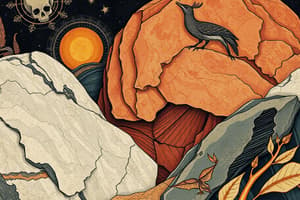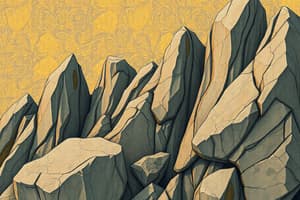Podcast
Questions and Answers
What type of rock is formed from the solidification of molten rock?
What type of rock is formed from the solidification of molten rock?
- Igneous (correct)
- Sedimentary
- Intrusive
- Metamorphic
Which of the following is a type of sedimentary rock?
Which of the following is a type of sedimentary rock?
- Granite
- Limestone (correct)
- Basalt
- Schist
What characterizes metamorphic rocks?
What characterizes metamorphic rocks?
- Made from rock fragments
- Result from the alteration of existing rocks under heat and pressure (correct)
- Formed from biological material
- Cooled quickly on the surface
Which rock type is described as having a layered appearance?
Which rock type is described as having a layered appearance?
What is a distinct property of calcite when exposed to hydrochloric acid?
What is a distinct property of calcite when exposed to hydrochloric acid?
Which property would you observe in a mineral demonstrating cleavage?
Which property would you observe in a mineral demonstrating cleavage?
What happens if a mineral shows fracture instead of cleavage?
What happens if a mineral shows fracture instead of cleavage?
Which rock is an example of an extrusive igneous rock?
Which rock is an example of an extrusive igneous rock?
What is the primary use of the Mohs scale of hardness in mineral identification?
What is the primary use of the Mohs scale of hardness in mineral identification?
What does the presence of striations on a mineral's surface indicate?
What does the presence of striations on a mineral's surface indicate?
How can one determine the streak color of a mineral?
How can one determine the streak color of a mineral?
What is likely true about a mineral that effervesces when dilute hydrochloric acid is applied?
What is likely true about a mineral that effervesces when dilute hydrochloric acid is applied?
Which of the following is NOT a characteristic of a true mineral?
Which of the following is NOT a characteristic of a true mineral?
What does the cleavage of a mineral refer to?
What does the cleavage of a mineral refer to?
Which type of fracture is described as being curved like a shell?
Which type of fracture is described as being curved like a shell?
Why might color not be a reliable property in mineral identification?
Why might color not be a reliable property in mineral identification?
What type of mineral texture is characterized by being fine-grained and too small to see individual crystals without magnification?
What type of mineral texture is characterized by being fine-grained and too small to see individual crystals without magnification?
Which of the following is a characteristic of intrusive igneous rocks?
Which of the following is a characteristic of intrusive igneous rocks?
What distinguishes mafic minerals from felsic minerals?
What distinguishes mafic minerals from felsic minerals?
How do the sizes of crystals in a rock relate to the cooling rate of magma?
How do the sizes of crystals in a rock relate to the cooling rate of magma?
Which type of rock forms from magma that has reached the Earth's surface?
Which type of rock forms from magma that has reached the Earth's surface?
What type of internal structure do minerals exhibit?
What type of internal structure do minerals exhibit?
What feature signifies an igneous rock as vesicular?
What feature signifies an igneous rock as vesicular?
Where does magma originate?
Where does magma originate?
What occurs at convergent boundaries?
What occurs at convergent boundaries?
How would you categorize a rock that is formed from fragments of pre-existing rocks?
How would you categorize a rock that is formed from fragments of pre-existing rocks?
What does well-sorted sediment indicate about the transport process?
What does well-sorted sediment indicate about the transport process?
What influences the rounding of a grain during transportation?
What influences the rounding of a grain during transportation?
Which size designation corresponds to very fine grains?
Which size designation corresponds to very fine grains?
What is the role of weathering compared to erosion?
What is the role of weathering compared to erosion?
Which type of sediment would you expect to find in a poorly sorted sample?
Which type of sediment would you expect to find in a poorly sorted sample?
Which of the following describes rounded grains?
Which of the following describes rounded grains?
Study Notes
Rock Types
- Igneous Rocks: Formed from molten rock (magma or lava).
- Intrusive: Cools slowly underground (e.g., granite).
- Extrusive: Cools quickly on the surface (e.g., basalt).
- Sedimentary Rocks: Created from the accumulation and compaction of sediments or the precipitation of minerals.
- Clastic: Made from rock fragments (e.g., sandstone).
- Chemical: Formed from mineral precipitation (e.g., limestone).
- Organic: Composed of biological material (e.g., coal).
- Metamorphic Rocks: Result from the alteration of existing rocks under heat and pressure.
- Foliated: Has layered appearance (e.g., schist).
- Non-foliated: Lacks layers (e.g., marble).
Mineral Identification Properties
- Cleavage: Smooth, flat surfaces where the mineral breaks (e.g., look for planes).
- Fracture: How the mineral breaks if it doesn't show cleavage (e.g., uneven, conchoidal, splintery).
- Angle between cleavage planes: Use a protractor or compare to known angles (e.g., 90°, 120°).
- Hardness: Use the Mohs scale of hardness to determine the mineral's resistance to scratching (e.g., fingernail, copper penny, glass, steel file).
- Luster: How the mineral reflects light (e.g., metallic, glassy, dull).
- Streak: The color of the powder left behind when rubbed on a streak plate.
- Striations: Fine, parallel lines on the mineral's surface.
- Effervescence (Reaction to acid): Fizzing or bubbling when a drop of dilute hydrochloric acid is applied, indicates the presence of carbonates (e.g., calcite, dolomite).
- Transparency/Opacity: Hold the mineral up to a light source to determine if it's transparent, opaque, or translucent.
- Color: Can be helpful for identification, but not always reliable due to impurities or variations in composition.
Mineral Requirements
- Naturally Occurring: Formed through natural geological processes.
- Inorganic: Not derived from living organisms.
- Solid: Rigid structure at standard temperature and pressure.
- Definite Chemical Composition: Specific chemical formula, although variations can occur.
- Ordered Internal Structure: Atoms arranged in a repeating pattern.
Igneous Rock Textures
- Aphanitic: Fine-grained texture, too small to see crystals without magnification. (Extrusive)
- Phaneritic: Coarse-grained texture, crystals visible to the naked eye. (Intrusive)
- Vesicular: Contains small holes (vesicles) formed by gas bubbles. Often light and porous. (Extrusive)
- Glassy: Smooth, glassy appearance, no visible crystals. Often breaks with a conchoidal fracture. (Extrusive)
Igneous Rock Colors
- Mafic: Dark-colored, rich in magnesium and iron (e.g., black or dark green).
- Intermediate: Mix of light and dark minerals, often gray or beige.
- Felsic: Light-colored, rich in silica (e.g., white, pink, or light gray).
Magma vs. Lava
- Magma: Molten rock beneath the Earth's surface.
- Lava: Magma that has reached the Earth's surface.
Crystal Size and Rock Formation
- Larger crystals indicate slower cooling (intrusive rocks).
- Smaller crystals indicate faster cooling (extrusive rocks).
Extrusive vs. Intrusive Rock Formation
- Extrusive Rocks: Form on the Earth's surface from volcanic eruptions.
- Intrusive Rocks: Form beneath the Earth's surface from magma cooling slowly.
Volcano Locations
- Convergent Boundaries: Where an oceanic plate subducts beneath a continental or oceanic plate, leading to volcanic activity.
- Divergent Boundaries: Where tectonic plates move apart, allowing magma to rise and create new crust.
Sedimentary Rock Properties
- Well-Sorted: Grains are similar in size and shape, indicating natural sorting.
- Poorly-Sorted: Grains vary widely in size and shape, indicating a mixed appearance.
- Grain Size Very Fine: Smaller than 0.0625 mm (clay).
- Grain Size Fine: 0.0625 mm to 0.25 mm (silt).
- Grain Size Medium: 0.25 mm to 2 mm (sand).
- Grain Size Coarse: 2 mm to 64 mm (granules).
- Grain Size Very Coarse: Larger than 64 mm (pebbles, cobbles).
- Angular Grains: Sharp edges & corners, indicating limited transport.
- Rounded Grains: Smooth, curved edges, indicating longer distance traveled and abrasion.
Sedimentary Rock Types
- Biogenic: Formed from organic material.
- Chemical: Formed from mineral precipitation from solution.
- Clastic: Composed of fragments of pre-existing rocks cemented together.
Grain Rounding and Transport
- As grains travel further, they collide with each other and surfaces, causing abrasion and rounding. Longer distance = more rounded grains.
Weathering vs. Erosion
- Weathering: The breakdown of rocks, soils, and minerals, through contact with the Earth's atmosphere, water, and biological organisms.
- Erosion: The movement of weathered material by natural forces like wind, water, and ice.
Studying That Suits You
Use AI to generate personalized quizzes and flashcards to suit your learning preferences.
Related Documents
Description
Explore the fascinating world of rocks in this quiz on igneous, sedimentary, and metamorphic types. Learn about their formation, characteristics, and the properties used in mineral identification. Test your knowledge on different rock types and their identification properties!




